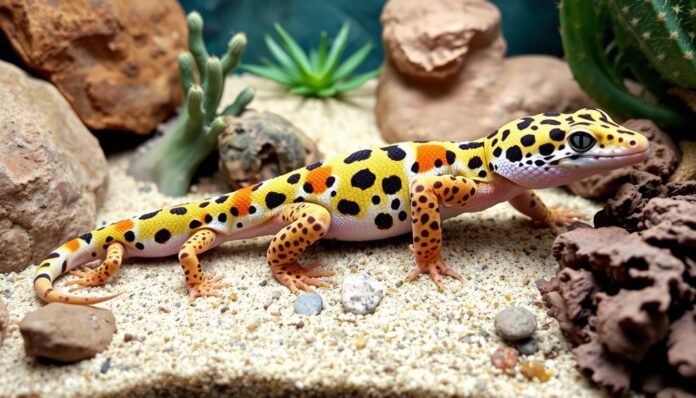Leopard geckos can live up to 20 years in captivity with the right care. This is almost three times longer than their 6-8 years in the wild. In the wild, they face dangers like predators and harsh weather. Knowing how to care for them is key to their long life in captivity.
This guide will cover all you need to know about leopard gecko care. We’ll look at their physical traits, natural habitat, and what they need to thrive. You’ll learn about housing, feeding, and keeping them healthy for a long life.
Understanding Leopard Geckos: Species Overview
Leopard geckos are named for their unique spots. They live on the ground and are most active at twilight. Found in dry lands of Afghanistan, India, and Pakistan, they have special features and behaviors.
Physical Characteristics
Adult leopard geckos are about 10 inches long. Babies start at 2.8-3.9 inches and weigh 2-5 grams. Females are smaller than males, with different body features.
Natural Habitat
Leopard geckos love dry, rocky places. They live in areas with clay soils and rocks. This helps them hide and stay safe from predators.
Behavior Patterns
Leopard geckos are most active at dawn and dusk. They hunt small animals and plants using their camouflage. They can even grow back their tails if they lose it.
How Long Do Leopard Geckos Live?
Leopard geckos are popular pets known for living a long time. In captivity, they can live up to 10 to 20 years with good care. Some have even lived up to 30 to 40 years.
Female leopard geckos might live a bit shorter because of egg-laying stress. But, the average pet gecko age shows they are very resilient. In the wild, they live about 6 to 8 years due to environmental challenges and predators.
The leopard gecko lifespan depends on genetics, diet, habitat, and healthcare. Geckos in captivity live longer because of better care and environments. They often live much longer than wild geckos.
Captive Leopard Geckos
| Lifespan Comparison | Wild Leopard Geckos | |
|---|---|---|
| Average Lifespan | 6-8 years | 10-20 years |
| Maximum Lifespan | 10 years | 30-40 years |
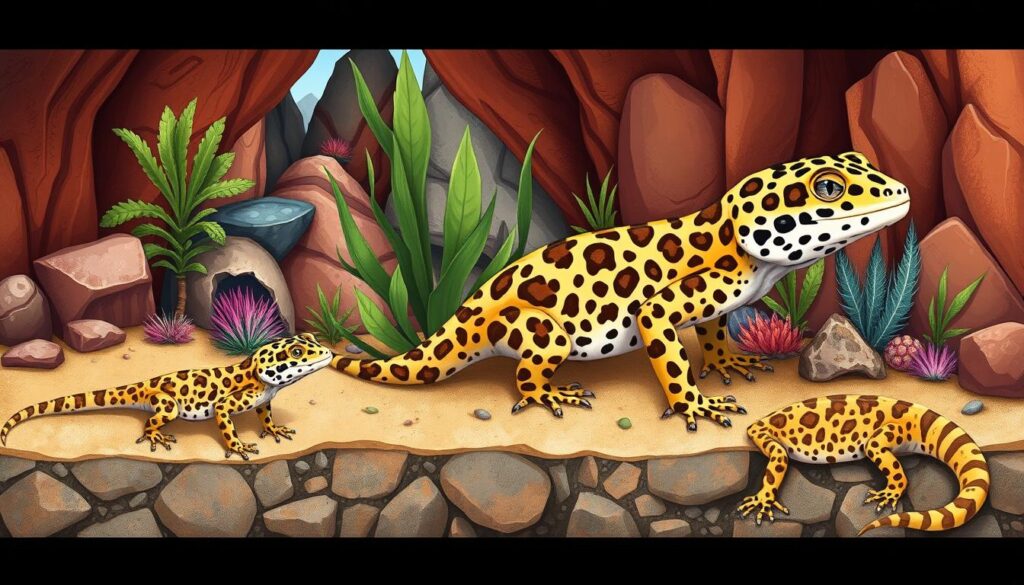
Leopard geckos in captivity can live a long time with the right care. They need a good environment and diet to thrive. With the right owner, they can be lifelong friends.
Wild vs. Captive Lifespan Comparison
Leopard geckos in the wild and those in captivity have different lifespans. Wild gecko lifespan is usually shorter, lasting from 6 to 8 years. They face many challenges like predators, parasites, and harsh weather, which can shorten their lives.
On the other hand, captive gecko care offers many benefits. Leopard geckos in captivity can live up to 10 to 20 years or more. This is because they have a controlled environment, less risk of being eaten, and better food and vet care. The gecko survival factors improve a lot in captivity, leading to longer lives for these reptiles.
Factors Affecting Wild Survival
- Predation from larger animals
- Exposure to parasites and diseases
- Harsh environmental conditions, such as extreme temperatures and limited resources
- Potential injuries or stress from interactions with other wild geckos
Benefits of Captive Care
- Controlled and stable environment with optimal temperature, humidity, and lighting
- Reduced risk of predation and aggressive interactions with other geckos
- Consistent and balanced diet, including supplementation of vitamins and minerals
- Access to veterinary care for early detection and treatment of health issues
By giving leopard geckos a safe, caring home and meeting their special needs, owners can help them live longer, healthier lives.
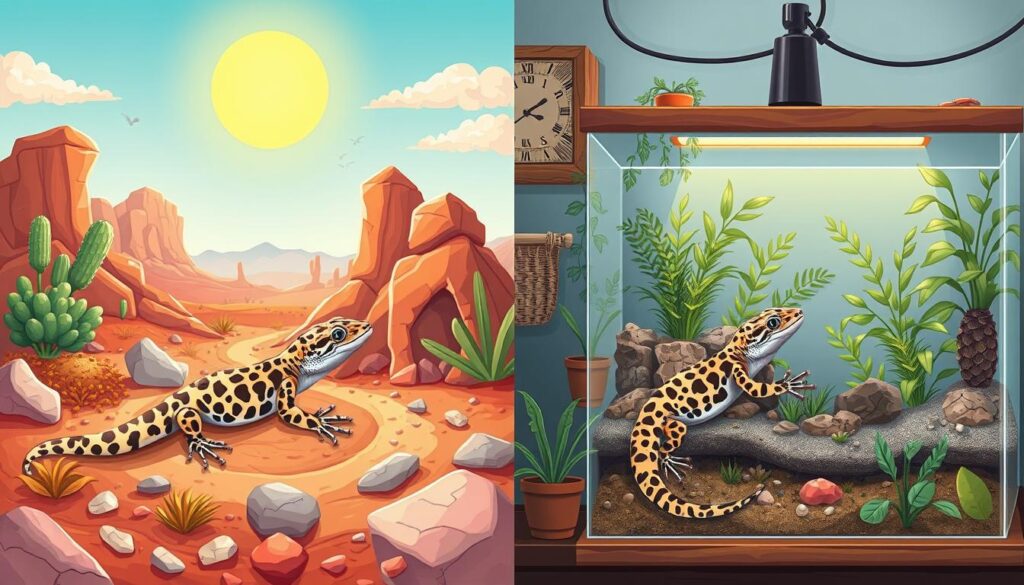
Leopard Gecko Life Stages and Growth
Leopard geckos go through different stages in their lives. Each stage has its own look and needs for food. Knowing about their growth helps us care for them better.
At first, they are hatchlings, about 3-4 inches long and 2-5 grams heavy. As they grow, they become juveniles. They reach 5 inches long and 15-25 grams by 2-7 months.
When they get closer to being adults, they are called sub-adults. They grow to 6-7 inches and 30-40 grams by 7-12 months. By 12 months or older, they are fully grown. Males can get up to 10 inches long and 50+ grams. Females are usually 7-8 inches and 45 grams.
| Life Stage | Length | Weight | Age |
|---|---|---|---|
| Hatchling | 3-4 inches | 2-5 grams | 0-2 months |
| Juvenile | 5 inches | 15-25 grams | 2-7 months |
| Sub-adult | 6-7 inches | 30-40 grams | 7-12 months |
| Adult | 7-10 inches | 45-120 grams | 12+ months |
Leopard geckos are ready to breed between 9-18 months. They stop growing around 1.5 years. Both males and females can live 15-20 years with good care and food.
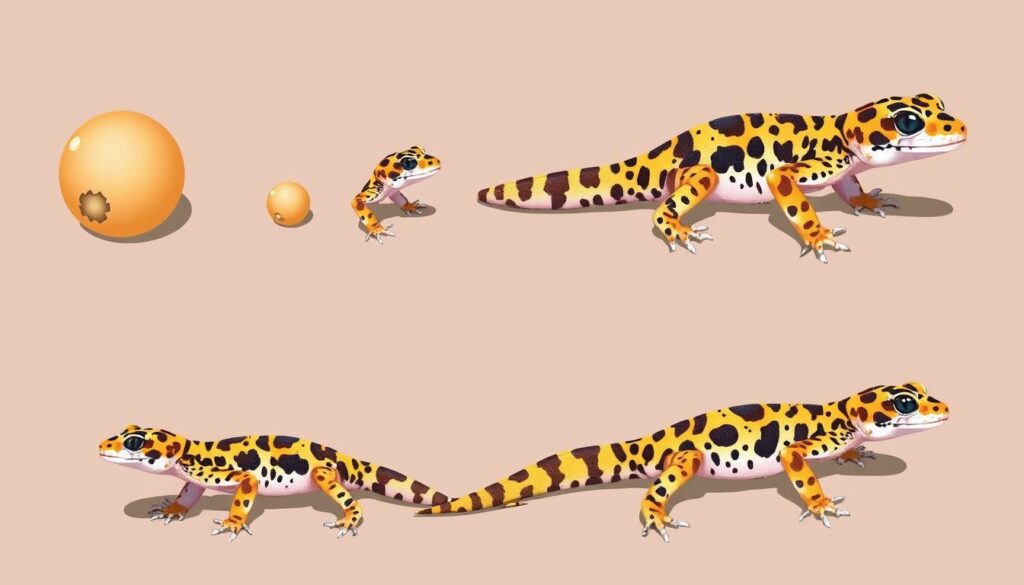
Essential Housing Requirements
Creating the right home is key for your leopard gecko’s health. You need to think about the size of their space, temperature, and lighting. Every detail matters to keep your gecko happy and healthy.
Enclosure Size and Setup
A single adult leopard gecko needs a 60cm x 40cm x 30cm space. This size lets them move and act naturally. If you want to keep more geckos, a 20-gallon tank is a good choice.
But, remember, don’t keep males together. They might fight over territory.
Temperature and Lighting
Leopard geckos need outside heat to stay warm. Keep their home warm, with a hot spot of 28-30°C and a cooler area of 24-26°C. Use a special lamp and thermostat to control the heat.
Also, add UVB lighting for 10-12 hours a day. This helps them make vitamin D3 and stay healthy.
Substrate Options
For the bottom of their home, mix 50% organic soil with 50% sand. Stay away from loose substrates like calcisand. They can cause problems if eaten.
Smooth surfaces like slate or paper towels are good too. Make sure there’s good air flow and keep humidity at 30-40%.
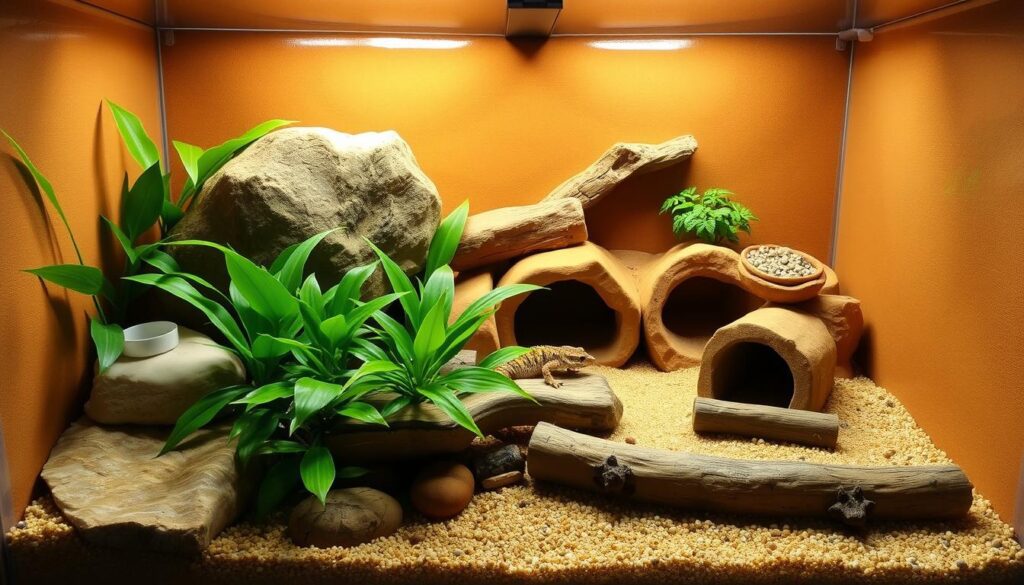
With a well-made and cared-for home, your leopard gecko will thrive. They’ll live a long, happy life with you.
Proper Nutrition and Feeding Guidelines
Feeding your leopard gecko the right food is key to its health and long life. Leopard geckos eat live insects like crickets, mealworms, and locusts. It’s important to feed these insects nutrient-rich foods 24-48 hours before giving them to your gecko.
Juvenile leopard geckos need to eat every day. Adult geckos can eat every other day. Feed them two insects that match their body length. Don’t overfeed to avoid obesity, as a healthy gecko has a wider tail than body.
| Gecko Age | Feeding Frequency | Feeder Insect Size |
|---|---|---|
| Baby | Daily | 3/8 inch |
| Juvenile | Daily | 1/4 inch |
| Adult | Every other day | Small adult to adult size |
Leopard geckos also need fresh water at all times. Treats like waxworms should be given sparingly because they are high in fat. Offer a washed dandelion or nasturtium flower once a month for extra nutrients.
Dust all insects with calcium and give multivitamin powder weekly for young geckos and every other week for adults. This helps your leopard gecko get the vitamins and minerals it needs for health and growth.
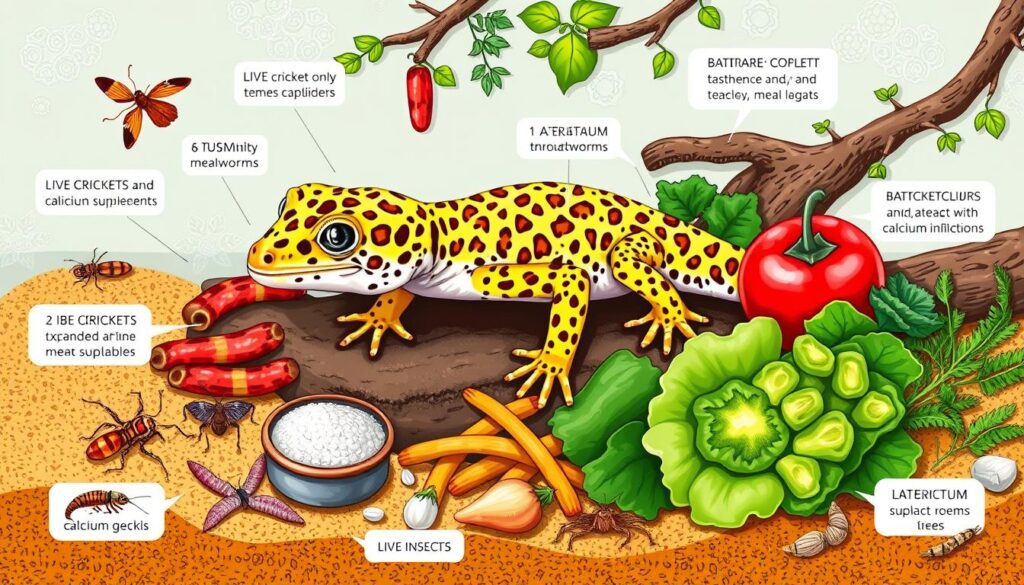
Health Maintenance and Disease Prevention
Keeping a leopard gecko healthy is key to a long, happy life in captivity. These lizards can get sick with metabolic bone disease, respiratory infections, retained shed, and parasites. It’s important to check their health often and get vet care early.
Common Health Issues
Metabolic bone disease is a big problem for leopard geckos. It happens when they don’t get enough calcium and vitamin D3. This can make their bones weak, make them tired, and even cause paralysis if not treated.
Keeping the right temperature and humidity in their home is also important. Respiratory infections, like pneumonia, can happen if these conditions are off. If a gecko can’t shed its skin properly, it can get sick too.
Regular Health Checks
It’s important to check your gecko’s health often. Look for changes in weight, appetite, or behavior. Annual vet visits and fecal tests are also a must to keep your gecko healthy.
Veterinary Care
For gecko health issues and leopard gecko diseases, you need a vet. A reptile vet can diagnose and treat problems. They can also teach you how to keep your gecko healthy.
Environmental Enrichment and Care
Keeping leopard geckos happy and healthy is more than just the basics. Adding environmental enrichment to their habitat is key. This includes creating a natural setup and providing fun activities. Here are some tips to make your gecko‘s life better.
Make sure your gecko has multiple hides in their enclosure. Include a humid hide with damp moss. This helps them feel safe and control their body temperature. Also, add climbing opportunities like low branches or rocks. This encourages them to explore and stay active.
Think about a bioactive setup for a more natural feel. Use a substrate that supports a mini-ecosystem with live plants and insects. Remember, regular cleaning and deep-cleans monthly are important for a healthy home.
Make sure your gecko has the right lighting cycles and temperature gradients. This helps them stay in sync with their natural environment. It’s good for their overall health.
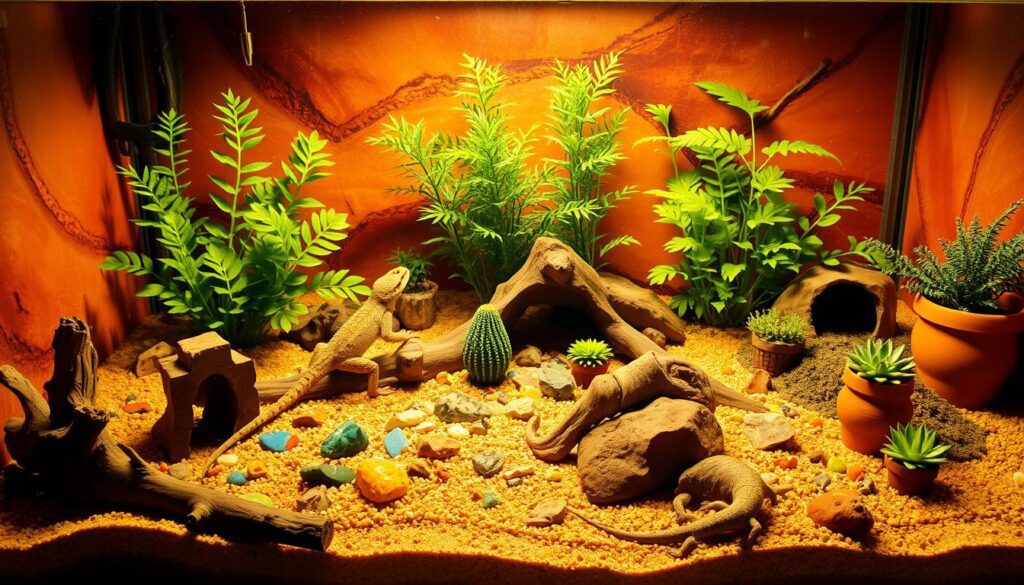
By following these gecko care tips, you’ll create a great leopard gecko habitat. A well-designed space reduces stress and encourages natural behavior. This leads to a happier, healthier pet.
Handling and Socialization Tips
Bringing a new leopard gecko home is exciting but needs care. It’s important to handle and socialize them right. This way, you can create a strong bond with your gecko.
Give your new gecko a week to get used to its new home before handling. This lets it feel safe and settled. After that, start with short, gentle handling sessions.
- Never grab a leopard gecko by its tail, as this can cause significant stress and even result in the gecko dropping its tail as a defense mechanism.
- Instead, scoop the gecko up gently from below, supporting its body and providing a sense of security.
- Always wash your hands before and after handling the gecko to prevent the spread of bacteria and maintain optimal health.
As your gecko gets used to you, you can handle it for longer. This helps it trust you more. By making handling a positive experience, you help your gecko feel comfortable around people.
| Key Handling Tips | Socialization Best Practices |
|---|---|
|
|
By following these handling leopard geckos and taming geckos tips, you can build a strong bond with your leopard gecko. This makes for a positive and enriching experience for both you and your pet.
Factors Affecting Longevity in Captivity
Leopard geckos can live over 20 years in captivity with the right care. Several factors can greatly affect their gecko lifespan factors and health. Knowing these is key for captive gecko care and increasing gecko longevity.
Genetics are very important for a leopard gecko’s long life. Good breeders focus on healthy traits to pass on to their geckos. Also, a gecko’s gender can affect its lifespan. Females usually live 15 to 20 years, while males live 8 to 10 years on average.
- Proper housing, including the right enclosure size, temperature regulation, and substrate, is essential for maintaining gecko health and reducing stress.
- A balanced, nutritious diet supplemented with appropriate vitamins and minerals can contribute significantly to a leopard gecko’s long-term well-being.
- Minimizing stress through gentle handling and a suitable, enriched environment is critical, as stress can severely impact a gecko’s lifespan.
- Regular veterinary check-ups and prompt treatment of any health issues can help extend a leopard gecko’s life expectancy.
By understanding and addressing these key gecko lifespan factors, owners can give their leopard geckos the best care. This helps them thrive and live long, healthy lives in captivity.
Conclusion
Leopard geckos make great pets, living up to twice as long as wild ones. With the right leopard gecko care summary, they become loyal friends. To keep them healthy, you need a good home, a balanced diet, and vet visits.
Meeting their special needs helps them thrive. This includes the right temperature, humidity, and activities. Each part of leopard gecko care summary is key to their happiness.
With care and commitment, leopard geckos can live a long, happy life. They can live over a decade in captivity. By knowing their needs and meeting them, you can enjoy their company for years.
FAQ
How long do leopard geckos live?
Leopard geckos can live up to 20 years in captivity. This is if they get the right care. In the wild, they usually live 6-8 years because of dangers and harsh weather.
What factors affect a leopard gecko’s lifespan?
Several things can affect how long a leopard gecko lives. These include their genes, what they eat, where they live, their health, and how stressed they are. Geckos in captivity live longer because they have better food, a safe place to live, and can see a vet.
How do wild and captive leopard geckos differ in lifespan?
Wild geckos face dangers like predators and harsh weather. This limits their life to 6-8 years. But, captive geckos can live 10-20 years or more. This is because they are safe from threats and get the care they need.
What are the distinct life stages of a leopard gecko?
Leopard geckos go through different stages. First, they are hatchlings for 0-2 months. Then, they are juveniles for 2-7 months. Next, they become sub-adults for 7-12 months. After that, they are adults for 12+ months. They can start breeding between 9-18 months and stop growing at 1.5 years.
What are the essential housing requirements for leopard geckos?
A 60cm x 40cm x 30cm vivarium is the minimum for one adult gecko. It needs a temperature range, proper lighting, and the right substrate. Choose a mix of soil and sand or rough slate. Make sure it’s well-ventilated and has humidity of 30-40%.
What should a leopard gecko’s diet consist of?
Leopard geckos eat insects. Give them live insects like crickets, mealworms, and locusts. Dust these insects with calcium and vitamins. Always have clean water available for them.
What are common health issues in leopard geckos?
Geckos can get metabolic bone disease, respiratory infections, and parasites. Check their health often, watch their weight and behavior, and take them to the vet once a year. Also, test for parasites.
How should leopard geckos be handled?
Let new geckos get used to their new home for a week before handling. Start with short, gentle sessions. Pick them up from below, not by the tail. Always wash your hands before and after touching them to avoid germs.


